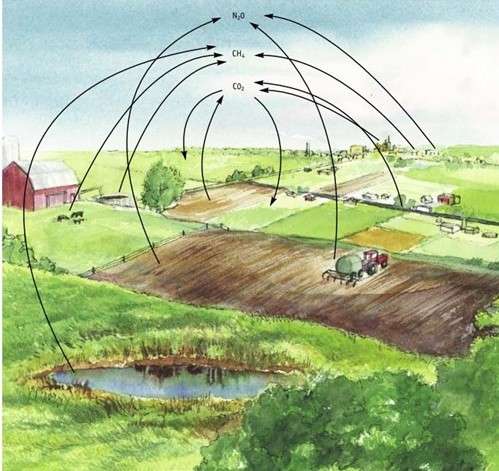By: Leia Weaver, NOFIA and Northeastern Ontario Regional Communications Coordinator
OMAFRA has released a new online feature for producers to help them measure their greenhouse gas (GHG) emissions on-farm and explore options for reducing their carbon footprint. This gives Ontario farmers another shovel in their shed to dig into understanding their own personal power to combat climate change. James Dyck, along with colleague Amadou Thiam and their team at OMAFRA, designed and built the new Greenhouse Gas decision support tool now available on AgriSuite. Using relevant and regularly updated data, they created algorithms to translate recent science and environmental best practices into a user friendly, online tool. The GHG tool is similar in framework and scope to the Holos tool previously designed and used by Agriculture and Agri-Food Canada. The new GHG tool is designed to be more accessible and less tedious for farmers to use, and specific to Ontario soil and weather data. It was launched in late December 2022.
Anyone interested can use the tool to input custom details about a farm operation, cost free, at https://agrisuite.omafra.gov.on.ca/ and by selecting the Greenhouse Gas option. No account is required to run the model, but it may be useful to login and save the results for future reference and updates. While the Greenhouse Gas tool is the newest feature, AgriSuite also offers resources for field management, crop nutrients, organic amendments, fertilizer, phosphorous loss assessment and manure storage sizing, with more to be added to the platform in the future. Producers can specify their farm type, operation size and location, and then discover suggested strategies. Alternative fuels, feeds, land use or cropping practices are some of the features under “Specify Mitigation Practices”.

A heat bar summary is produced to represent the annual greenhouse gas emissions for the entire farm operation. Emissions from methane, nitrous oxide and carbon dioxide reduction and sequestration are all considered in the calculation. The summary table also displays the results that could be achieved by using relevant beneficial management practices to reduce emissions or increase carbon sequestration.
The tool can also show any projected increase in emissions due to developments like a new barn, field, or flock. On-farm energy sources can be investigated for heating, lighting, drying and machinery fuel options. However, OMAFRA does warn that the estimates are approximate and may change appreciably as new scientific findings emerge.
Mitigation practices can include reducing tillage, using nitrate inhibitors, covering manure storage, or managing the diet of an animal to reduce methane emissions, depending on the farm type specified. Fertilizer reduction or incorporation methods, and use of cover crop practices and tree plantings can be considered in the calculation.
The tool currently stops at the farm gate. It is not able to build in emission considerations for transportation of inputs or shipping products at this point. Any economic benefit or loss of any changes is not built into the tool.
The objective is to help farmers see what emissions mean within their own operation, and to consider some more sustainable options. This doesn’t necessarily mean reducing fertility. For example, a reduction in nitrogen emissions can be achieved by losing less and holding more in the field for longer through options like inhibitors. OMAFRA’s GHG tool can be used by farmers to make better decisions related to environmental performance and may be able to support management decisions and investments which reduce greenhouse gas emissions. Existing tools such as the Environmental Farm Plan and the Farmland Health Check-Up can also provide guidance to farmers to improve environmental outcomes. Some industry groups such as the dairy sector are also looking at ways to document and measure environmental performance.
The tool is not meant to be a static resource – as new data becomes available, the tool will be refined. For example, it is not able to capture perennials like grapes and tree fruits, as currently the focus is on annual crops as that is where the data is the strongest. Background information and documents on environmental best management practices for reducing emissions can also be found at AgriSuite under the Resources tab. Farmers are encouraged to try the tool out and communicate their questions and feedback to OMAFRA staff.
